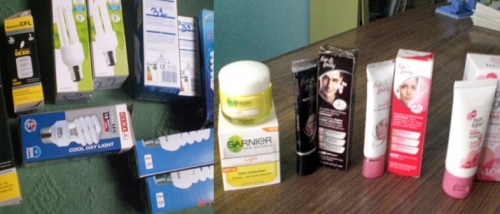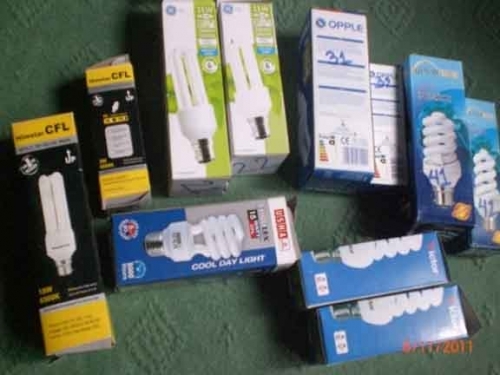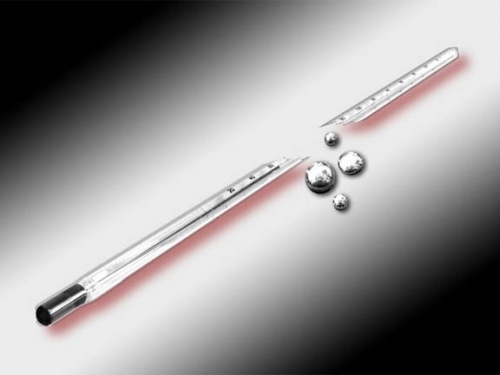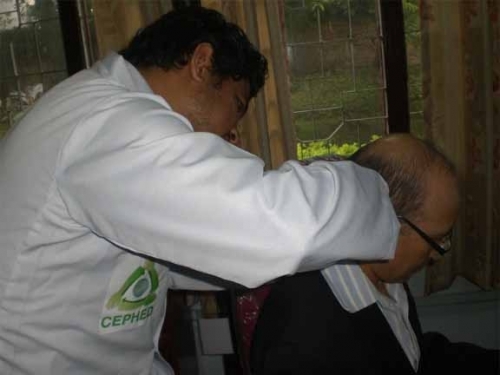Mercury (R)

Mercury is a pollutant of global concerns. Mercury is a chemical element that occurs in nature and can be found almost everywhere in the environment. Mercury is only metal which is liquid at ordinary temperature; in fact it is liquid at 298 Kelvin. Mercury is sometimes called quicksilver because of its silvery-white appearance. It is naturally occurring heavy, odorless, lustrous liquid metal found mainly in three forms: metallic; inorganic and organic. Organic form of mercury is highly toxic in comparison to other forms inorganic form and elemental forms.
Mercury based equipments and chemicals are being massively imported and used in various sectors in Nepal. The major consumer of the mercury in Nepal are found to be health care sector where large number of mercury base equipments such as Mercury thermometer, sphygmomanometer, some preservatives, and massively the mercury dental amalgam and in the Ayurvedic medicines. In addition to that our study found that very large number of the lighting system such as mercury tube light and CFL has been imported into the country without having any policy on end of life management. In addition to the products and equipments, a large quantity of the elemental mercury has been found to be imported in Nepal.
CEPHED has been engaged in the study of total mercury release from Health Care System of Nepal as well as developing more mercury free health care services. Research on mercury in CFL ,cosmetic products (Skin Whitening Creams), Bio-monitoring of Mercury in Fishes, Fisher Folks, Dental Doctors, Nurses, Female with Child Bearing age, Waste Management officials has been taken CEPHED.
| Study of Mercury and Power Factor of selected CFL Brands from Nepalese markets |
 |
Nepalese market has been flooded with several electrical and electronic shops, as there is low level of awareness and completely absence of any regulatory authority as well as any regulatory legal framework for the end of life management of electrical and electronic items. Additionally CFL has been promoted by all agencies like government, non-government, business community, private sector and even media houses. It became the gift item on the top of selling of several other products such as newspapers, inverter, generators etc without any thought of their end-of-life management. As CFL contains mercury, there is a need of end of life management with environmentally sound manner. An indicative study of Mercury level in 11 different CFL units from Nepalese market of different wattage and of different brands. All the CFL found to have mercury contain in them with the high potential to cause the environmental damage as well as impact on human health. |
Study of Mercury in Cosmetics (Mercury in Skin whitening Creams and Lotions)
 |
Nepalese market has been flooded with several registered un registered cosmetics products by authorized as well as authorized dealers and retailers. As there is low level of awareness and completely absence of any regulatory authority as well as any regulatory legal framework, an indicative study Mercury in Skin Whitening Cream and Moisturizer Lotion has been conducted by laboratory testing of seven selected national, multinational and international products of skin whitening creams and moisturizing lotion. Certain brands of skin whitening creams and moisturizing lotion found in Nepalese market and mostly used by the general public have been found to be contained some amount of mercury hazardous for health of people. |
report can be download:poisonous cosmetics
Estimation of Mercury Usage and Release from Healthcare Instruments in Nepal
 |
|
According to the study conducted by Center for Public Health and Environmental Development (CEPHED) in 2010, thermometer breakage rate in the hospitals ranged from 0.48 to 3.44 per bed per year. From the same estimation it can be resulted that Nepal has 501.75 kg (125.15 kg +376.6 kg) of mercury usage in thermometers and sphygmomanometers used in health care sector. Total annual mercury release from thermometers can be 125.85 kg. Per capita mercury stored in thermometers and sphygmomanometers can be calculated by dividing mercury usage with total population (i.e. 501.75 kg /28, 58, 4975), which is equal to 17.55 mg. Similarly, total annual per capita mercury release from thermometers can be estimated to be 4.40 mg.
Results of Mercury Level in Indoor Air of Hospital showed very high concentrations (up to 3.92 microgram per cubic meter) in certain locations and wards (CEPHED 2011) as compared to international standards by The Environmental Protection Agency (EPA), 0.3 μgm-3. However, over 90 per cent of the hospital locations and wards has been found to be mercury free. Even dental department of mercury free model hospital developed by CEPHED under WHO and SSNC support has been found zero level of mercury in the ambient and ward environment. This is direct evidence of positive outcomes of the intervention made by CEPHED with the support of these funding agencies in Nepal.
Biomonitoring of Mercury contamination in Fish and Human Hair in Nepal
 |
Humans become exposed to Hg and methylmercury primarily through the consumption of fish. Many national and international health organizations recognize the risks associated with a diet high in fish and international guidelines for the maximum amount of Hg in fish have been established. However, adhering to and enforcing these guidelines is very difficult, particularly in developing and transition countries where data on Hg in fish are rare or unknown. The primary goal of this reports prepared under Global Fish and Community Mercury Monitoring project is to generate new data, raise awareness about global Hg pollution, and identify specific hot spots, primarily from developing and transition countries. CEPHED contributed to Global Fish and Community Mercury Monitoring by carrying out the biomonitoring of fish and human hair about the presence of mercury in them from Nepal. For study of Hg concentration in Fish and Human body all together 20 human hair samples and 19 fish samples were collected. 15 fishes sample were collected from Fewa Lake whereas 4 fishes sample were from Kalimati market in Kathmandu suspected to be imported from India have been incuded. Include the common and scientific names of the fish species we had collected. Similarly, 15 human hair samples were collected from the fishing community of Khapaudi,Sarangkot-2, Kaski and 5 samples from nurses and doctors working in the dentistry health care services at National Dental Hospital, Kathmandu were included in the study. Samples were collecfted and sent to Biodiversity Research Institute (BRI), Gorham, USA lab for mercury testing. Mercury has been found in fish found in Phewa Lake as well as sold in Kathmandu Market and also in the human body including that of dentist doctors and nurses. |
Biomonitoring of Mercury Contamination in Health Care Professional in Nepal
 |
Samples were collected and sent to Biodiversity Research Institute (BRI), Gorham, USA lab for mercury testing. A total of 56 hair samples from 56 individual exposed to mercury due to their dental health problem as well as occupational exposure largely among the Dental Doctor including the high level government officials such as Secretary from Ministry of Health and Population (MOHP) and Joint Secretary from Ministry of Science, Technology and Environment (MOSTE) has been studied. This time joint initiatives of CEPHED and NDA bio-monitoring of mercury among 50 Dental Doctors and 4 Dental Assistant and other 2 once again confirmed the 100 % positive mercury contamination results ranges from 0.097 to 0.547 among all the dental health care professionals. Mercury has been found in people with mercury dental filling in their mouth as well as also in the health care professional such as Dental Doctors, Dental Assistant and Housekeeping in charge working in several dental hospitals of Nepal. |
Briefing paper of mercury volume 1:Mercury Briefing Paper Final, CEPHED, 2015 February
Briefing paper of mercury volume 2:Mercury Briefing Paper Final 2018
With reference to your call for information on “Gender and Mercury” please find the following problem of mercury and gender identified in Nepal despite being the least explored area that needs to be extensively explored. There are limited studies with reference to human health and environmental impacts of mercury in Nepal. Though small, such studies could reveal the fact that some sectors have very high levels of mercury contamination, such as the fisher communities, hoteliers and gold plating workers in Nepal. Some also included into the MIA Report of Nepal 2019 (P 60-61) submitted to MC Secretariat. Some of them are listed as follows.
CEPHED has been raising these research based issues alongwith preparation, production, dissemination of several research based IEC materials like Posters, Briefing Papers, Fact Sheets, Bio monitoring reports, Radio and Video PSA as well as carried out several district, regional and national level awareness and capacity building workshop on Mercury including Policy Level stakeholder workshop to address Mercury Free Dentistry and Mercury Free Health Care services. Carried out a series of bio monitoring studies including in fish, fisher folk, metal plating workers, ayurvedic medicine industry workers etc., study of mercury in cosmetics, toys, CFL and campaigned for the required regulatory and institutional framework. As a result, the Government of Nepal, Ministry of Health and Population has taken very progressive decisions and banned import and use of all mercury based equipment since July 2013 and Dental amalgam since 21st August 2019. Served as the team member for preparing MIA Report 2019 for Nepal. Our campaign is ongoing for pushing for ratification of the Minamata Convention as soon as possible.
Pls find the final Short Video of Mercury Free Health Care Initiative in Nepal https://youtu.be/KKxa5TYeuEM
Please find another metal plating video ( no sound) clearly explaining the whole process and level of exposure. MC Convention Secretariat should urgently address these important issues and requested to be included in my submission. https://youtu.be/Tk9HZUYQc6s
Please find attached our letter of submission, briefing papers and other documents that provide more detailed information related to our engagement with this mercury issue in Nepal.




